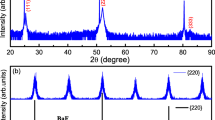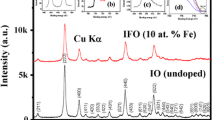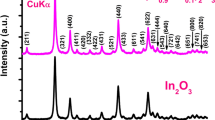Abstract
The results of the studies of structural and magnetic properties of Fe-doped \({\mathrm{TlGaSe}}_{2}\) (\({\mathrm{TlGa}}_{1-\mathrm{x}}{\mathrm{Fe}}_{\mathrm{x}}{\mathrm{Se}}_{2}\)) layered magnetic semiconductor grown with two different doping concentrations (\(x\)) are presented. Electron paramagnetic resonance (EPR) investigations revealed that Fe3+ ions are located at the centers of GaSe4 tetrahedra formed by Se atoms and the site symmetry around Fe3+ centers are orthorhombic. The crystal field parameters of the structure have been calculated by fitting the orthorhombic spin Hamiltonian using rotation patterns of EPR spectra. The crystal field parameters and rhombicity ratio (\({\lambda }^{^{\prime}}\)) estimated from magnetization and EPR measurements of \({\mathrm{TlGa}}_{1-\mathrm{x}}{\mathrm{Fe}}_{\mathrm{x}}{\mathrm{Se}}_{2}\) crystals are found to be larger and lower for samples with higher and lower dilution ratios respectively. Structural stability, electronic and magnetic properties of the Fe-doped \({\mathrm{TlGaSe}}_{2}\) four-layer slab were explored using density functional theory (DFT) calculations. We have found that substituting \(\mathrm{Fe}\) single dopant atom at the \(\mathrm{Ga}\) site, and the formation of substitutional \({\mathrm{FeSe}}_{4}\) complexes due to the strong hybridization between the electronic states of the dopants and the neighboring \(\mathrm{Se}\) atoms are geometrically and energetically favorable for \({\mathrm{TlGa}}_{1-\mathrm{x}}{\mathrm{Fe}}_{\mathrm{x}}{\mathrm{Se}}_{2}\). Our calculations indicate that the magnetic coupling between Fe dopants and the neighboring \(\mathrm{Se}\) atoms is dominantly ferromagnetic. While weakly antiferromagnetic interactions between Fe–Fe dopants due to the super-exchange mechanism is favorable. The positive value of the Curie temperature together with the observed antiferromagnetic hysteresis loops as well as with the characteristic temperature dependence of magnetic susceptibility indicate the existence of combined antiferromagnetic and weak ferromagnetic ordering between interacting unpaired spin orbitals of Fe3+ ions in \({\mathrm{TlGa}}_{1-\mathrm{x}}{\mathrm{Fe}}_{\mathrm{x}}{\mathrm{Se}}_{2}\) compounds are important experimental confirmations of theoretical predictions. The saturation magnetization for \({\mathrm{TlGa}}_{1-\mathrm{x}}{\mathrm{Fe}}_{\mathrm{x}}{\mathrm{Se}}_{2}\) compound is found to increase with increasing of the Fe3+ dopant concentration.











Similar content being viewed by others
Data availability
The data that support the findings of this study are available from the corresponding author upon reasonable request.
References
G.A. Prinz, Magnetoelectronics. Science 282, 1660–1663 (1998). https://doi.org/10.1126/science.282.5394.1660
H. Ohno, Making nonmagnetic semiconductors ferromagnetic. Science 281, 951–956 (1998). https://doi.org/10.1126/science.281.5379.951
S.A. Wolf, D.D. Awschalom, R.A. Buhrman, J.M. Daughton, S. vonMolnar, M.L. Roukes, A.Y. Chtchelkanova, D.M. Treger, Spintronics: a spin-based electronics vision for the future. Science 294, 1488–1495 (2001). https://doi.org/10.1126/science.1065389
Y. Matsumoto, M. Murakami, T. Shono, T. Hasegawa, T. Fukumura, M. Kawasaki, P. Ahmet, T. Chikyow, S. Koshihara, H. Koinuma, Room-temperature ferromagnetism in transparent transition metal-doped titanium dioxide. Science 291, 854–856 (2001). https://doi.org/10.1126/science.1056186
F. Mikailzade, A.G. Şale, S. Kazan, R.I. Khaibullin, N.I. Khalitov, V.I. Nuzhdin, T.G. Mammadov, Magnetic properties of Co implanted TlInS2 and TlGaSe2 crystals. Solid State Commun. 152, 407–409 (2012). https://doi.org/10.1016/j.ssc.2011.11.046
M. Maksutoglu, F.A. Mikailzade, M.Y. Seyidov, T.G. Mammadov, A.A. Sukhanov, N.M. Lyadov, V.F. Valeev, R.I. Khaibullin, Magnetic resonance and magnetization studies of Fe implanted TlInS2 and TlGaSe2 crystals. Mater. Res. Express. 6, 76109 (2019). https://doi.org/10.1088/2053-1591/ab1510
S. Gökçe, T.G. Mammadov, A.I. Najafov, F. Mikailzade, M.Y. Seyidov, Synthesis and magnetic characterizations of TlIn1-xFexS2 solid solution with x= 0016 as a new low-dimensional dilute magnetic-semiconductor material. J. Magn. Magn. Mater. (2022). https://doi.org/10.1016/j.jmmm.2022.169068
W. Henkel, H.D. Hochheimer, C. Carlone, A. Werner, S. Ves, H.G.V. Schnering, High-pressure Raman study of the ternary chalcogenides TlGaS2, TlGaSe2, TlInS2, and TlInSe2. Phys. Rev. B. 26, 3211 (1982). https://doi.org/10.1103/PhysRevB.26.3211
D. Müller, H. Hahn, Untersuchungen über ternäre Chalkogenide. XXIV. Zur Struktur des TlGaSe2. Zeitschrift Für Anorg. Und Allg. Chemie. 438, 258–272 (1978). https://doi.org/10.1002/zaac.19784380128
A. Cengiz, Y.M. Chumakov, M. Erdem, Y. Şale, F.A. Mikailzade, M.Y. Seyidov, Origin of the optical absorption of TlGaSe2 layered semiconductor in the visible range. Semicond. Sci. Technol. 33, 75019 (2018). https://doi.org/10.1088/1361-6641/aac97b
S. Yang, M. Wu, H. Wang, H. Cai, L. Huang, C. Jiang, S. Tongay, Ultrathin ternary semiconductor TlGaSe 2 phototransistors with broad-spectral response. 2D Mater. 4, 35021 (2017). https://doi.org/10.1088/2053-1583/aa80c7
F.A. Mikailov, B.Z. Rameev, S. Kazan, F. Yildiz, T.G. Mammadov, B. Aktaş, EPR spectra of Fe3+ centers in layered TlGaSe2 single crystal. Solid State Commun. 133, 389–392 (2005). https://doi.org/10.1016/j.ssc.2004.11.026
M. Açıkgöz, S. Kazan, F.A. Mikailov, T.G. Mammadov, B. Aktaş, Structural phase transitions in Fe3+-doped ferroelectric TlGaSe2 crystal. Solid State Commun. 145, 539–544 (2008). https://doi.org/10.1016/j.ssc.2008.01.009
W. Kohn, L.J. Sham, Self-consistent equations including exchange and correlation effects. Phys. Rev. 140, A1133 (1965). https://doi.org/10.1103/PhysRev.140.A1133
P. Hohenberg, W. Kohn, Inhomogeneous electron gas. Phys. Rev. 136, B864 (1964). https://doi.org/10.1007/s12045-017-0529-3
J.P. Perdew, K. Burke, M. Ernzerhof, Generalized gradient approximation made simple. Phys. Rev. Lett. 77, 3865 (1996). https://doi.org/10.1103/PhysRevLett.77.3865
J.M. Soler, E. Artacho, J.D. Gale, A. García, J. Junquera, P. Ordejón, D. Sánchez-Portal, The SIESTA method for ab initio order-N materials simulation. J. Phys. Condens. Matter. 14, 2745 (2002). https://doi.org/10.1088/0953-8984/14/11/302
D.R. Hamann, Optimized norm-conserving Vanderbilt pseudopotentials. Phys. Rev. B. 88, 85117 (2013). https://doi.org/10.1103/PhysRevB.88.085117
D.R. Hamann, Erratum: optimized norm-conserving vanderbilt pseudopotentials [Phys. Rev. B 88, 085117 (2013)]. Phys. Rev. B. 95, 239906 (2017). https://doi.org/10.1103/PhysRevB.95.239906
M. Schlipf, F. Gygi, Optimization algorithm for the generation of ONCV pseudopotentials. Comput. Phys. Commun. 196, 36–44 (2015). https://doi.org/10.1016/j.cpc.2015.05.011
S. Grimme, Semiempirical GGA-type density functional constructed with a long-range dispersion correction. J. Comput. Chem. 27, 1787–1799 (2006). https://doi.org/10.1002/jcc.20495
I. Morrison, D.M. Bylander, L. Kleinman, Nonlocal Hermitian norm-conserving Vanderbilt pseudopotential. Phys. Rev. B. 47, 6728 (1993). https://doi.org/10.1103/PhysRevB.47.6728
N. Troullier, J.L. Martins, Efficient pseudopotentials for plane-wave calculations. Phys. Rev. B. 43, 1993 (1991). https://doi.org/10.1103/PhysRevB.43.8861
T. Ozaki, Variationally optimized atomic orbitals for large-scale electronic structures. Phys. Rev. B. 67, 155108 (2003). https://doi.org/10.1103/PhysRevB.67.155108
T. Ozaki, H. Kino, Numerical atomic basis orbitals from H to Kr. Phys. Rev. B. 69, 195113 (2004). https://doi.org/10.1103/PhysRevB.69.195113
S.L. Dudarev, G.A. Botton, S.Y. Savrasov, C.J. Humphreys, A.P. Sutton, Electron-energy-loss spectra and the structural stability of nickel oxide: an LSDA+ U study. Phys. Rev. B. 57, 1505 (1998). https://doi.org/10.1103/PhysRevB.57.1505
A. Il Liechtenstein, M.I. Katsnelson, V.P. Antropov, V.A. Gubanov, Local spin density functional approach to the theory of exchange interactions in ferromagnetic metals and alloys. J. Magn. Magn. Mater. 67, 65–74 (1987). https://doi.org/10.1016/0304-8853(87)90721-9
M.J. Han, T. Ozaki, J. Yu, Electronic structure, magnetic interactions, and the role of ligands in Mn n (n= 4, 12) single-molecule magnets. Phys. Rev. B. 70, 184421 (2004). https://doi.org/10.1103/PhysRevB.70.184421
A. Terasawa, M. Matsumoto, T. Ozaki, Y. Gohda, Efficient algorithm based on liechtenstein method for computing exchange coupling constants using localized basis set. J. Phys. Soc. Japan. 88, 114706 (2019). https://doi.org/10.7566/JPSJ.88.114706
S. Ozdemir, M. Bucurgat, Photoelectrical properties of TlGaSe2 single crystals. Solid State Sci. 33, 25–31 (2014). https://doi.org/10.1016/j.solidstatesciences.2014.04.006
S. Johnsen, Z. Liu, J.A. Peters, J.-H. Song, S.C. Peter, C.D. Malliakas, N.K. Cho, H. Jin, A.J. Freeman, B.W. Wessels, M.G. Kanatzidis, Thallium chalcogenide-based wide-band-gap semiconductors: TlGaSe2 for radiation detectors. Chem. Mater. 23, 3120–3128 (2011). https://doi.org/10.1021/cm200946y
C.F. Holder, R.E. Schaak, Tutorial on powder X-ray diffraction for characterizing nanoscale materials. ACS Nano 13, 7359–7365 (2019). https://doi.org/10.1021/acsnano.9b05157
M. Nakamura, H. Nakamura, K. Shimamura, N. Ohashi, Growth and characterization of a gallium monosulfide (GaS) single crystal using the Bridgman method. J. Cryst. Growth. 573, 126303 (2021). https://doi.org/10.1016/j.jcrysgro.2021.126303
J. Guo, J. Jian, J. Liu, B. Cao, R. Lei, Z. Zhang, B. Song, H. Zhao, Synthesis of SnSe nanobelts and the enhanced thermoelectric performance in its hot-pressed bulk composite. Nano Energy 38, 569–575 (2017). https://doi.org/10.1016/j.nanoen.2017.06.033
Y. Li, X. Shi, D. Ren, J. Chen, L. Chen, Investigation of the anisotropic thermoelectric properties of oriented polycrystalline SnSe. Energies 8, 6275–6285 (2015). https://doi.org/10.3390/en8076275
M. Jin, S. Lin, W. Li, Z. Chen, R. Li, X. Wang, Y. Chen, Y. Pei, Fabrication and thermoelectric properties of single-crystal argyrodite Ag8SnSe6. Chem. Mater. 31, 2603–2610 (2019). https://doi.org/10.1021/acs.chemmater.9b00393
S. Stoll, A. Schweiger, EasySpin, a comprehensive software package for spectral simulation and analysis in EPR. J. Magn. Reson. 178, 42–55 (2006). https://doi.org/10.1016/j.jmr.2005.08.013
G.E. Delgado, A.J. Mora, F.V. Perez, J. Gonzalez, Growth and crystal structure of the layered compound TlGaSe2. Cryst. Res. Technol. J. Exp. Ind. Crystallogr. 42, 663–666 (2007). https://doi.org/10.1002/crat.200610885
P. Gnutek, M. Açıkgöz, C. Rudowicz, Superposition model analysis of the zero-field splitting parameters of Fe3+ doped in TlInS2 crystal—Low symmetry aspects. Opt. Mater. (Amst) 32, 1161–1169 (2010). https://doi.org/10.1016/j.optmat.2010.03.024
S.K. Misra, C. Rudowicz, Effect of monoclinic symmetry on the EPR spectra of Gd3+-doped hydrated single crystals of rare-earth trichlorides. Phys. Status Solidi. 147, 677–684 (1988). https://doi.org/10.1002/pssb.2221470226
T.H. Yeom, C. Rudowicz, S.H. Choh, D.G. McGavin, Monoclinic spin hamiltonian analysis of EPR spectra of Mn2+ in BiVO4 single crystals. Phys. Status Solidi. 198, 839–851 (1996). https://doi.org/10.1002/pssb.2221980229
J.A. Weil, J.R. Bolton 2007 Electron paramagnetic resonance: elementary theory and practical applications. John Wiley & Sons
A. Abragam, B. Bleaney, Electron paramagnetic resonance of transition ions (Oxford University Press, Oxford, UK, 2012)
S. Stoll, Spect. Simul. Solid-state Elect. Paramagn Res (2003). https://doi.org/10.3929/ethz-a-004529758
https://easyspin.org/easyspin/documentation/frames.html, (2023). . (accessed March 2, 2023).
M. Açikgöz, Analysis of zero-field splitting parameters of Fe3+ Doped TlGaS2 crystal using spin hamiltonian separation (SHS) method. J. Supercond. Nov. Magn. 25, 2697–2700 (2012). https://doi.org/10.1007/s10948-011-1245-y
C. Rudowicz, R. Bramley, On standardization of the spin Hamiltonian and the ligand field Hamiltonian for orthorhombic symmetry. J. Chem. Phys. 83, 5192–5197 (1985). https://doi.org/10.1063/1.449731
M.Y. Seyidov, Y. Sahin, M.H. Aslan, R.A. Suleymanov, Mechanisms of current flow in p-TlGaSe2 single crystals. Semicond. Sci. Technol. 21, 1633 (2006). https://doi.org/10.1088/0268-1242/21/12/022
M.Y. Seyidov, F.A. Mikailzade, T. Uzun, A.P. Odrinsky, E. Yakar, V.B. Aliyeva, S.S. Babayev, T.G. Mammadov, Identification of intrinsic deep level defects responsible for electret behavior in TlGaSe2 layered semiconductor. Phys. B Condens. Matter. 483, 82–89 (2016). https://doi.org/10.1016/j.physb.2015.12.004
M.Y. Seyidov, R.A. Suleymanov, E. Balaban, Y. Şale, Imprint electric field controlled electronic transport in TlGaSe2 crystals. J. Appl. Phys. 114, 93706 (2013). https://doi.org/10.1063/1.4819396
M.Y. Seyidov, Y. Sahin, D. Erbahar, R.A. Suleymanov, Electret states and current oscillations in the ferroelectric semiconductor TlGaSe2. Phys. Status Solidi. 203, 3781–3787 (2006). https://doi.org/10.1002/pssa.200622236
A.K. Fedotov, M.I. Tarasik, I.A. Svito, P. Zhukowski, T.N. Koltunowicz, T.G. Mammadov, M.Y. Seyidov, R.A. Suleymanov, V. Grivickas, V. Bicbaevas, Electrical properties of the layered single crystals TlGaSe2 and TlInS2. (2012) https://elib.bsu.by/handle/123456789/27440.
J.M.D. Coey, Magnetism and magnetic materials (Cambridge University Press, Cambridge, UK, 2010)
B.D. Cullity, C.D. Graham 2009 Introduction to Magnetic Materials. A John Wiley & Sons. 2nd Edit.
J.K. Furdyna, J. Kossut, Eds Semiconductors and Semimetals vol. 25 (Boston: Academic) Furdyna JK 1988 J, 1988.
D.C. Mattis, Theory Of magnetism made simple, the: an introduction to physical concepts and to some useful mathematical methods. World Sci. Pub. Comp. (2006). https://doi.org/10.1142/5372
J.C. Bonner, M.E. Fisher, Linear magnetic chains with anisotropic coupling. Phys. Rev. 135, A640 (1964). https://doi.org/10.1103/PhysRev.135.A640
X. Song, S.N. Schneider, G. Cheng, J.F. Khoury, M. Jovanovic, N. Yao, L.M. Schoop, Kinetics and evolution of magnetism in soft-chemical synthesis of CrSe2 from KCrSe2. Chem. Mater. 33, 8070–8078 (2021). https://doi.org/10.1021/acs.chemmater.1c02620
E. Okumuş, S.T. Öztürk, M.H.Y. Seyidov, Magnetic properties of manganese doped TlInS2 layered semiconductor: Diamagnetic to paramagnetic transitions at low temperatures, in: AIP Conf. Proc., AIP Publishing LLC. 30028 (2019). https://doi.org/10.1063/1.5135426.
G. Bertotti, Hysteresis in magnetism: for physicists, materials scientists, and engineers (Academic Press San Diego, London Boston New York Sydney Tokyo Toronto, 1998)
E.D. Torre, Magnetic hysteresis, New York, (1999).
G.C. Hadjipanayis, Magnetic Hysteresis in Novel Magnetic Materials (Springer, Dordrecht, 1997)
A. Ślawska-Waniewska, M. Gutowski, H.K. Lachowicz, T. Kulik, H. Matyja, Superparamagnetism in a nanocrystalline Fe-based metallic glass. Phys. Rev. B. 46, 14594 (1992). https://doi.org/10.1103/PhysRevB.46.14594
A. Hernando, T. Kulik, Exchange interactions through amorphous paramagnetic layers in ferromagnetic nanocrystals. Phys. Rev. B. 49, 7064 (1994). https://doi.org/10.1103/PhysRevB.49.7064
E.C. Stoner, E.P. Wohlfarth, A mechanism of magnetic hysteresis in heterogeneous alloys. Philos. Trans. R Soc. London. Ser. A Math. Phys. Sci. 240, 599–642 (1948). https://doi.org/10.1109/TMAG.1991.1183750
P. Giannozzi, S. Baroni, N. Bonini, M. Calandra, R. Car, C. Cavazzoni, D. Ceresoli, G.L. Chiarotti, M. Cococcioni, I. Dabo, QUANTUM ESPRESSO: a modular and open-source software project for quantum simulations of materials. J. Phys. Condens. Matter. 21, 395502 (2009). https://doi.org/10.1088/0953-8984/21/39/395502
Funding
Not applicable.
Author information
Authors and Affiliations
Contributions
The manuscript was written through contributions of all authors. All authors have given approval to the draft version of the manuscript. SG: planned and performed the experiments, carried out data analysis, performed calculations, wrote original draft. TGM and AIN: synthesized the samples. SB: Conceptualization of theoretical section, Formal analysis, Investigation, Writing—original draft, Visualization. FM: Conceptualization of experimental section, Investigation, Validation, Writing—review & editing, Supervision. MYS: Conceptualization of experimental section, Investigation, Validation, Writing—review & editing wrote the manuscript draft.
Corresponding author
Ethics declarations
Conflict of interests
The authors declare no conflict of interest.
Ethical approval
Not applicable.
Additional information
Publisher's Note
Springer Nature remains neutral with regard to jurisdictional claims in published maps and institutional affiliations.
Supplementary Information
Below is the link to the electronic supplementary material.
Rights and permissions
Springer Nature or its licensor (e.g. a society or other partner) holds exclusive rights to this article under a publishing agreement with the author(s) or other rightsholder(s); author self-archiving of the accepted manuscript version of this article is solely governed by the terms of such publishing agreement and applicable law.
About this article
Cite this article
Gökçe, S., Mammadov, T., Najafov, A. et al. Magnetic Ordering in TlGa1-xFexSe2 Dilute Magnetic Semiconductors with Various Fe Dilution Ratios. Appl Magn Reson 54, 535–559 (2023). https://doi.org/10.1007/s00723-023-01539-6
Received:
Revised:
Accepted:
Published:
Issue Date:
DOI: https://doi.org/10.1007/s00723-023-01539-6




